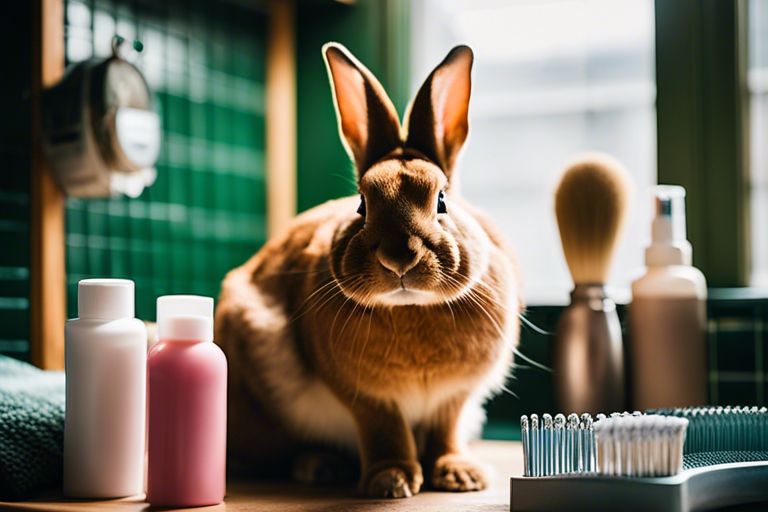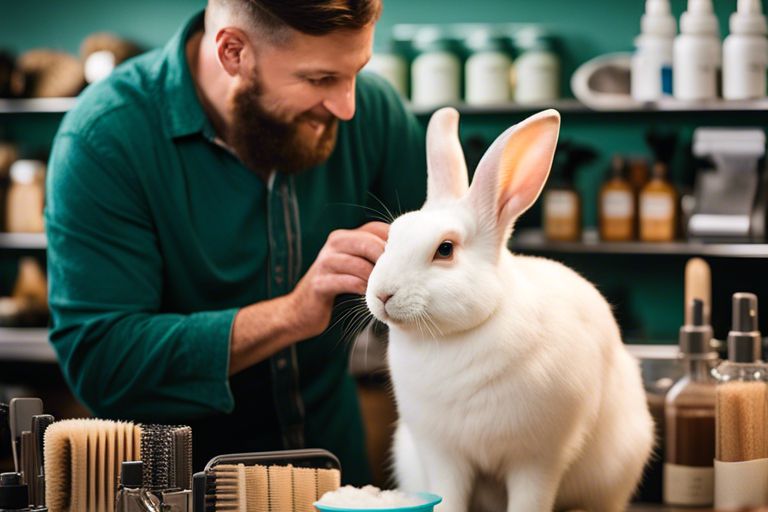Are you tired of dealing with unsightly fur discoloration in your beloved Flemish Giant rabbits? Whether you’re a seasoned breeder or a first-time owner, it’s essential to be proactive in preventing this common issue. Improper diet and hygiene are often the culprits behind fur discoloration, which can lead to serious health problems if left unchecked. In this blog post, we’ll provide you with expert tips on how to maintain the quality of your rabbit’s fur and keep them looking and feeling their best. By making a few simple adjustments to your rabbit care routine, you can avoid potential health risks and ensure your Flemish Giants have beautiful, healthy fur for years to come.
Key Takeaways:
- Proper grooming: Regularly brush and groom your Flemish Giant rabbit to prevent fur discoloration.
- Provide a clean living environment: Keep your rabbit’s living space clean to prevent buildup of dirt and debris that can cause fur discoloration.
- Monitor diet: Ensure your rabbit is receiving a balanced diet to maintain healthy fur and prevent discoloration.
- Avoid excessive sunlight: Protect your rabbit from prolonged exposure to direct sunlight, which can cause fur to fade or change color.
- Avoid stress: Minimize stress in your rabbit’s environment to prevent fur discoloration, as stress can contribute to changes in fur color.
Genetics and Fur Color
Assuming you are a Flemish Giant rabbit owner who wants to prevent fur discoloration, it’s important to understand the role of genetics in determining fur color. Flemish Giant rabbits come in a variety of colors, including white, black, blue, fawn, and steel grey. The color of a rabbit’s fur is determined by the combination of genes inherited from its parents.
Genes Influencing Coloration
When it comes to fur color in Flemish Giant rabbits, there are several genes that play a role in determining the outcome. The C series gene determines the overall color of the rabbit, with different variations leading to different base colors. The D series gene affects the concentration and distribution of pigment in the fur, leading to variations in shading and pattern. Understanding these genetic factors can help you make informed breeding decisions to preserve the quality of fur color in your rabbits.
Breeding for Color Preservation
When breeding Flemish Giant rabbits, it’s essential to carefully select breeding pairs to preserve the coloration of the offspring. By choosing rabbits with desirable fur colors and understanding their genetic makeup, you can minimize the risk of fur discoloration in future generations. Additionally, avoiding inbreeding and seeking guidance from experienced breeders can help maintain the integrity of fur color in Flemish Giant rabbits.
Nutritional Factors
Some nutritional factors can have a significant impact on the fur color of your Flemish Giant rabbits. It is important to pay attention to their diet to ensure that their fur remains in optimal condition. Below are some essential considerations:
- Dietary Protein: An adequate amount of high-quality protein is essential for maintaining a healthy fur color. Ensure that your rabbits’ diet includes proper protein sources such as hay, pellets, and fresh vegetables.
- Hydration: Proper hydration is crucial for overall health and the maintenance of a vibrant fur color. Make sure your rabbits have access to clean and fresh water at all times.
- Essential Nutrients: Ensure that your rabbits’ diet includes a balanced combination of essential nutrients such as vitamins, minerals, and fiber to support overall health and fur color.
Assume that nutritional imbalances can lead to discoloration of fur, so it’s important to provide a well-rounded diet for your Flemish Giants.
Impact of Diet on Fur Color
The impact of diet on the fur color of your Flemish Giant rabbits cannot be overstated. Your rabbits’ diet directly influences the quality and vibrancy of their fur. A balanced diet that includes a variety of essential nutrients is crucial for maintaining the desired fur coloration.
Essential Vitamins and Minerals
Ensuring that your Flemish Giant rabbits receive adequate essential vitamins and minerals is vital for maintaining a healthy fur color. Vitamins A, E, and D, as well as minerals such as copper and zinc, play key roles in fur pigmentation and overall health. Make sure your rabbits’ diet includes these essential nutrients to support optimal fur coloration.
Environmental Influences
Despite proper grooming and care, the fur of your Flemish Giant rabbit can still be affected by environmental factors. Paying attention to sunlight exposure, temperature, and humidity can help prevent discoloration and maintain the quality of your rabbit’s fur.
Sunlight and Discoloration
Excessive exposure to sunlight can lead to fur discoloration in Flemish Giant rabbits. The ultraviolet (UV) rays in sunlight can cause the pigments in the fur to break down, resulting in a change in color. To prevent this, ensure that your rabbit has access to shaded areas when spending time outdoors. Additionally, consider applying pet-safe sunscreen to their fur to provide extra protection against UV rays.
Temperature and Humidity Effects
The temperature and humidity levels in your rabbit’s environment can also impact the quality of their fur. Extreme heat can cause the fur to become dry and brittle, leading to discoloration and an overall decline in fur health. On the other hand, high humidity can create the perfect environment for fur mites, which can also affect the fur’s color and texture. Maintaining a comfortable temperature and humidity level in your rabbit’s living space is crucial for preventing fur discoloration and ensuring their overall well-being.
It is important to monitor the sunlight exposure and environmental conditions in your rabbit’s living space to prevent fur discoloration and maintain the quality of their fur.
| Factors | Impact on Fur |
| Sunlight Exposure | Can cause pigments to break down, leading to discoloration |
| Temperature | Extreme heat can make fur dry and brittle |
| Humidity | High humidity can create a favorable environment for fur mites |
Grooming and Care Techniques
To ensure the fur of your Flemish Giant rabbit remains healthy and vibrant, proper grooming and care techniques are essential. By following these guidelines, you can prevent fur discoloration and maintain your rabbit’s overall well-being.
Proper Cleaning Procedures
When it comes to cleaning your Flemish Giant rabbit, it’s important to be gentle yet thorough. Use a soft brush to gently remove any dirt, debris, or loose fur from your rabbit’s coat. You should also bathe your rabbit occasionally, using a mild, rabbit-safe shampoo. Rinse thoroughly to ensure no residue is left behind.
Products to Avoid
It’s crucial to be cautious about the products you use on your Flemish Giant rabbit. Avoid using any harsh or chemical-laden shampoos, as these can strip the natural oils from your rabbit’s fur, leading to dryness and potential discoloration. Additionally, refrain from using any products that are not specifically designed for rabbits, as they may contain ingredients that can be harmful to your pet.
By following these proper cleaning procedures and being mindful of the products you use, you can ensure that your rabbit’s fur remains healthy and vibrant. Remember to always prioritize gentle, rabbit-safe grooming practices to maintain the overall well-being of your beloved Flemish Giant rabbit. Doing so will help prevent fur discoloration and maintain the health of your pet.
Health Concerns and Fur Discoloration
For Flemish Giant rabbits, fur discoloration can sometimes be a sign of underlying health issues. This breed is prone to certain health concerns that can affect the condition of their fur. It’s important to be aware of these potential health issues and how they can impact the appearance of your rabbit’s fur. In this chapter, we will discuss common health concerns that can lead to fur discoloration in Flemish Giants and what you can do to prevent and address them.
Recognizing Underlying Health Issues
If you notice that your Flemish Giant rabbit’s fur is becoming discolored, it could be a sign of an underlying health problem. Skin problems in rabbits can manifest in various ways, including changes in fur color and texture. These issues can be caused by parasites, infections, allergies, or other health conditions. It’s important to pay attention to any changes in your rabbit’s fur and skin, as they can provide valuable clues about their overall health.
When to Consult a Veterinarian
If you suspect that your Flemish Giant rabbit is experiencing health issues that are affecting the color or condition of their fur, it’s important to consult a veterinarian. Skin problems in rabbits can be complex and require professional diagnosis and treatment. If you notice any concerning changes in your rabbit’s fur, such as bald patches, scaling, redness, or unusual discoloration, it’s best to seek veterinary care promptly. Your vet can conduct a thorough examination and recommend the appropriate course of action to address any underlying health issues.

The Importance of Preventing Fur Discoloration in Flemish Giant Rabbits
The key to preventing fur discoloration in your Flemish Giant rabbits is to maintain a clean and dry living environment for them. Regularly clean their cages and provide them with ample bedding to absorb any moisture. Additionally, avoid using wire flooring in their cages to prevent urine from splashing onto their fur. Ensuring that your rabbits have a balanced diet and proper grooming is also crucial in preventing fur discoloration. By following these preventative measures, you can help your Flemish Giant rabbits maintain a healthy and vibrant coat.
FAQ
Q: Why do Flemish Giant rabbits experience fur discoloration?
A: Flemish Giant rabbits can experience fur discoloration due to a variety of factors such as genetics, diet, living environment, and lack of grooming. Some rabbits may also experience fur discoloration as a result of health issues, parasites, or stress.
Q: What diet is best to prevent fur discoloration in Flemish Giant rabbits?
A: To prevent fur discoloration in Flemish Giant rabbits, it is important to provide a balanced diet that includes high-quality hay, fresh vegetables, and a limited amount of pellets. Avoid feeding your rabbit foods high in carbohydrates and sugars, as these can contribute to fur discoloration. Additionally, ensure your rabbit has access to clean, fresh water at all times.
Q: How can I maintain the health and appearance of my Flemish Giant rabbit’s fur?
A: To maintain the health and appearance of your Flemish Giant rabbit’s fur, make sure to groom them regularly by gently brushing their fur to remove any loose hair, dirt, or debris. Providing a clean and spacious living environment for your rabbit, along with regular vet check-ups, can also help prevent fur discoloration. Additionally, addressing any health or stress issues promptly can contribute to the overall well-being and appearance of your rabbit’s fur.
